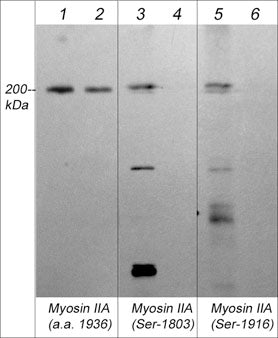Anti-Myosin IIA Heavy Chain (Ser-1916), Phosphospecific Antibody
- SPECIFICATION
- CITATIONS
- PROTOCOLS
- BACKGROUND

| Primary Accession | P35579 |
|---|---|
| Reactivity | Bovine, Chicken |
| Host | Rabbit |
| Clonality | Rabbit Polyclonal |
| Isotype | IgG |
| Calculated MW | 226532 Da |
| Gene ID | 4627 |
|---|---|
| Other Names | NMHC-IIA, MYH9, myosin heavy chain |
| Target/Specificity | on-muscle myosin II is an actin-based motor protein essential to cell motility, division, migration, adhesion and polarity. This myosin forms a hexameric complex comprised of two heavy chains (NMHC-II), two essential light chains, and two regulatory light chains (RLC). In vertebrates, there are three NMHC-II isoforms (NMHC-IIA, NMHC-IIB, and NMHC-IIC), which exhibit distinct patterns of expression in cells and tissues. Regulation of NMHC-II activity occurs through RLC and HC phosphorylation. RLCs are phosphorylated at Thr-18 and Ser-19, which activates myosin II motor activity and promotes filament stability. By contrast, PKC phosphorylation of Ser-1/Ser-2 and Thr-9 in RLC may decrease activated myosin II interaction with actin. Several kinases phosphorylation NMHC-II isoforms directly. TRPM7 phosphorylates Thr-1800, Ser-1803, and Ser-1808, which reduces NMHC-IIA incorporation into the actin cytoskeleton. PKC phosphorylates NMHC-IIA on Ser-1916 and NMHC-IIB on multiple tailpiece serines leading to inhibition of filament assembly. Casein kinase II phosphorylates NMHC-IIA on Ser-1943 and increases disassembly of NMHC-IIA filaments. |
| Storage | Maintain refrigerated at 2-8°C for up to 6 months. For long term storage store at -20°C in small aliquots to prevent freeze-thaw cycles. |
| Precautions | Anti-Myosin IIA Heavy Chain (Ser-1916), Phosphospecific Antibody is for research use only and not for use in diagnostic or therapeutic procedures. |
| Shipping | Blue Ice |

Thousands of laboratories across the world have published research that depended on the performance of antibodies from Abcepta to advance their research. Check out links to articles that cite our products in major peer-reviewed journals, organized by research category.
info@abcepta.com, and receive a free "I Love Antibodies" mug.
Provided below are standard protocols that you may find useful for product applications.
Background
on-muscle myosin II is an actin-based motor protein essential to cell motility, division, migration, adhesion and polarity. This myosin forms a hexameric complex comprised of two heavy chains (NMHC-II), two essential light chains, and two regulatory light chains (RLC). In vertebrates, there are three NMHC-II isoforms (NMHC-IIA, NMHC-IIB, and NMHC-IIC), which exhibit distinct patterns of expression in cells and tissues. Regulation of NMHC-II activity occurs through RLC and HC phosphorylation. RLCs are phosphorylated at Thr-18 and Ser-19, which activates myosin II motor activity and promotes filament stability. By contrast, PKC phosphorylation of Ser-1/Ser-2 and Thr-9 in RLC may decrease activated myosin II interaction with actin. Several kinases phosphorylation NMHC-II isoforms directly. TRPM7 phosphorylates Thr-1800, Ser-1803, and Ser-1808, which reduces NMHC-IIA incorporation into the actin cytoskeleton. PKC phosphorylates NMHC-IIA on Ser-1916 and NMHC-IIB on multiple tailpiece serines leading to inhibition of filament assembly. Casein kinase II phosphorylates NMHC-IIA on Ser-1943 and increases disassembly of NMHC-IIA filaments.
If you have used an Abcepta product and would like to share how it has performed, please click on the "Submit Review" button and provide the requested information. Our staff will examine and post your review and contact you if needed.
If you have any additional inquiries please email technical services at tech@abcepta.com.













 Foundational characteristics of cancer include proliferation, angiogenesis, migration, evasion of apoptosis, and cellular immortality. Find key markers for these cellular processes and antibodies to detect them.
Foundational characteristics of cancer include proliferation, angiogenesis, migration, evasion of apoptosis, and cellular immortality. Find key markers for these cellular processes and antibodies to detect them. The SUMOplot™ Analysis Program predicts and scores sumoylation sites in your protein. SUMOylation is a post-translational modification involved in various cellular processes, such as nuclear-cytosolic transport, transcriptional regulation, apoptosis, protein stability, response to stress, and progression through the cell cycle.
The SUMOplot™ Analysis Program predicts and scores sumoylation sites in your protein. SUMOylation is a post-translational modification involved in various cellular processes, such as nuclear-cytosolic transport, transcriptional regulation, apoptosis, protein stability, response to stress, and progression through the cell cycle. The Autophagy Receptor Motif Plotter predicts and scores autophagy receptor binding sites in your protein. Identifying proteins connected to this pathway is critical to understanding the role of autophagy in physiological as well as pathological processes such as development, differentiation, neurodegenerative diseases, stress, infection, and cancer.
The Autophagy Receptor Motif Plotter predicts and scores autophagy receptor binding sites in your protein. Identifying proteins connected to this pathway is critical to understanding the role of autophagy in physiological as well as pathological processes such as development, differentiation, neurodegenerative diseases, stress, infection, and cancer.


